英语词汇学第3章
- 格式:ppt
- 大小:182.00 KB
- 文档页数:33
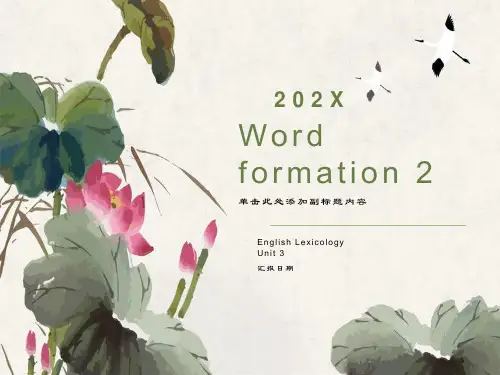
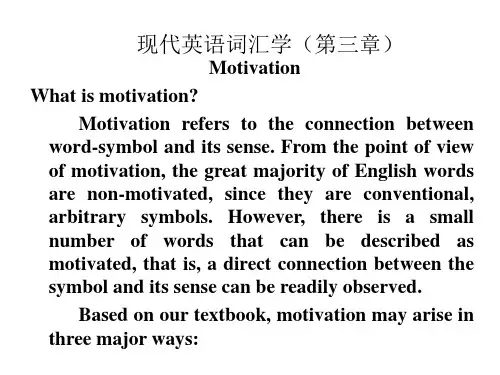
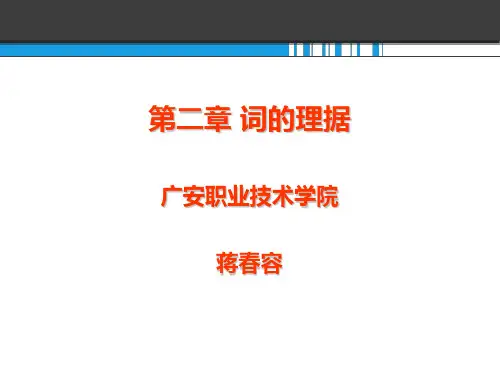
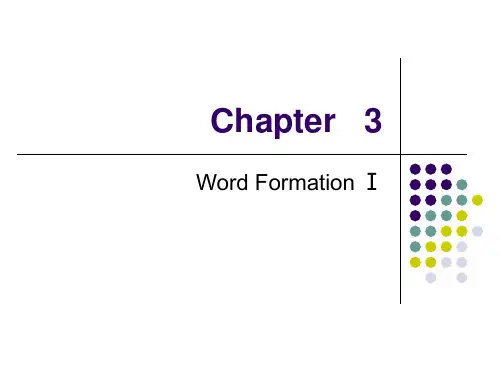
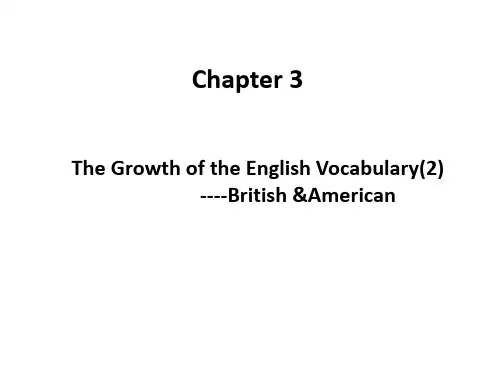
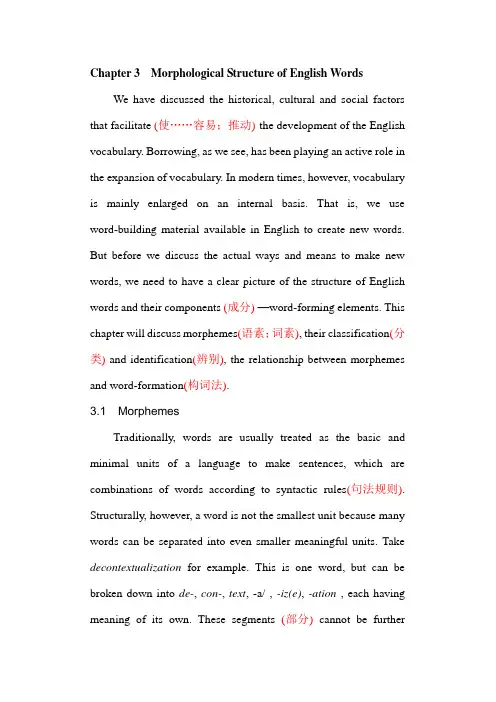
Chapter 3 Morphological Structure of English Words We have discussed the historical, cultural and social factors that facilitate (使……容易;推动) the development of the English vocabulary. Borrowing, as we see, has been playing an active role in the expansion of vocabulary. In modern times, however, vocabulary is mainly enlarged on an internal basis. That is, we use word-building material available in English to create new words. But before we discuss the actual ways and means to make new words, we need to have a clear picture of the structure of English words and their components (成分) —word-forming elements. This chapter will discuss morphemes(语素;词素), their classification(分类) and identification(辨别), the relationship between morphemes and word-formation(构词法).3.1 MorphemesTraditionally, words are usually treated as the basic and minimal units of a language to make sentences, which are combinations of words according to syntactic rules(句法规则). Structurally, however, a word is not the smallest unit because many words can be separated into even smaller meaningful units. Take decontextualization for example. This is one word, but can be broken down into de-, con-, text, -a/ , -iz(e), -ation , each having meaning of its own. These segments (部分) cannot be furtherdivided; otherwise, none of them would make any sense. Though -ation has a number of variants (变体) such as -tion, -sion, -ion, they belong to the same suffix as they have the same meaning and grammatical function and occur owing to (因为;根据) different sound environment. These minimal meaningful units are known as morphemes (morphe is the Greek word for 'form'; -eme as in 'phoneme' (音素) means 'class of' ). In view of word-formation, the morpheme is seen as 'the smallest functioning unit in the composition of words' (Crystal 1985). Syntactically(从句法上看), however, a morpheme is the minimal form of grammatical analysis (语法分析). For instance, each of the word-forms studies, studying, studied, consists of the morpheme study + ; the forms -es in studies, -ing in studying, -ed in studied are morphemes, which express grammatical concepts (语法概念) instead of deriving new words (See Classifying Morphemes).3.2 Morphs and Allomorphs(词素变体)Morphemes are abstract units, which are realized in speech by discrete units (具体单位) known as morphs(形素). 'They are actual spoken, minimal carriers of meaning' (Bolinger and Sears 1981:43). In other words the phonetic or orthographic strings(语音串或拼写字串)or segments (切分成分;节) which realize morphemes are termed 'morphs' (Bauer 1983:15). The morpheme isto the morph what a phoneme (音位) is to a phone (音素). Most morphemes are realized by single morphs like bird, tree, green , sad, want, desire, etc. . These morphemes coincide (巧合) with words as they can stand by themselves and function freely in a sentence. Words of this kind are called mono-morphemic words. Some morphemes, however, are realized by more than one morph according to their position in a word. For instance, the morpheme of plurality {-s} has a set of morphs in different sound context, e. g. in cats /s/, in bags /z/, in matches /iz/. The alternates (作为替换的事物) /s/, /z/ and /iz/ are three different morphs. The same is true of the link verb morpheme {be}. Its past tense is realized by two distinct orthographic forms was , were, each of which happens to be a word-form, realizing {preterit} and {singular}, and {preterit} and {plural} respectively and each has its own phonetic form /woz/ or /wə:/. Therefore, both was, were and their phonetic forms /woz/ and /wə: / are morphs (See discussion in Bauer, p15).An allomorph refers to a member of a set of morphs, which represent one morpheme. Just as we class phones(音素) together as allophones (音位变体) of a single phoneme(音位), so we class morphs together as allomorphs of a single morpheme. Take the plural morpheme {-s} again. Phonetically, it is realized by /s/, /z/, /iz/, all of which are allomorphs. In English, many morphemes canhave more than one allomorph, particularly those freestanding morphemes which are functional words in their own right. Once they occur in connected speech, they may be realized by different forms, depending on whether they are accented or weakened (Look at the data in the table).Morphem e AllomorphStrong Weak{am} /aem/ /əm/, /m/{ was} /woz/ /WəZ/{have } /haev/ /həv/, /v/{would } /wud/ /wəd/, /əd/,/d/{he} /hi:/ /i:/, /i/{his} /hiz/ /iz/{for} /fo:/ /fə/{to} /tu:/ /tu/, /tə/Then what is the difference between morphs and allomorphs? The relationship can be illustrated by the diagram below.Morpheme{would}morph morph morph morph →allomorph/wud/ /wəd/ /əd/ /d/3.3 Classifying MorphemesMorphemes vary in function. Accordingly, we can classify morphemes into several general categories: free versus bound, derivational versus inflectional, and lexical versus grammatical. However, their boundaries are not as clear-cut as they appear to be due to some overlapping(重叠). For the sake of discussion, we shall define each type in terms of its characteristics.1. Free versus Bound Morphemes(自由词素与粘着词素)This is the easiest and most preferred classification in morphological studies, discussed in Hatch and Brown (1995), Crystal (1985), Fromkin and Rodman (1983), Bauer (1983), Bolinger and Sears (1981) and Matthews (2000). Morphemes which are independent of other morphemes are free. These morphemes have complete meanings in themselves and can be used as free grammatical units in sentences. They are identical with(与……完全相同) words, for example, man, earth, wind, car and anger.Morphemes which cannot occur as separate words are bound. They are so named because they are bound to other morphemes to form words or to perform a particulargrammatical function.Bound morphemes are chiefly found in derived words (派生词). Let us take recollection, idealistic and ex-prisoner for example. Each of the three words comprises three morphemes: recollection (re- collect-ion) , idealistic (ideal-ist-ic) , ex-prisoner (ex- prison -er). Of the nine morphemes, collect, ideal and prison can stand by themselves and thus are free morphemes. All the rest re-, -ion , -ist, -ic, ex-and -er are bound as none of them are freestanding units.Free morphemes are all roots, which are capable of being used as words or as word-building elements to form new words like collect, ideal, prison , whereas bound morphemes consist of either roots or affixes, most of which can be used to create new words like -dict- , -ced- (接近;去), re-, -ion, -ist, -ic and ex-(前). But there are a few affixes which can only indicate such grammatical concepts as tense, aspect, number and case, for example, the -ing in watching, -er in easier, -s in books, and -ed in worked.The English language possesses a multitude of (大量的) words made up of merely bound morphemes, e. g. antecedent, which can be broken down into ante-, -ced- and -ent. Among them, -ced- is a root meaning 'approach, go to', ante-, a prefix meaning 'before' and -ent, a noun suffix meaning 'a person, a thing', thus the whole word antecedent meaning 'something that goes before'(前例;前事;先行词;祖先). These examples show clearly that bound morphemes include two types: bound root (See Root, Stem, Base) and affix.2. Derivational versus Inflectional MorphemesMorphemes which are used to derive new words are known as derivational morphemes (派生词素) because when these morphemes are conjoined, new words are derived.In English, derivatives and compounds are all formed by such morphemes. For example, a + mor + ai, clear + ance, Life + Like and homo + gen + eous are results of such morphological processes.Inflectional morphemes(屈折词素), in contrast, indicate the syntactic relationships between words and function as grammatical markers. Inflectional morphemes are confined to suffixes. There is the regular plural suffix -s (-es) which is added to nouns such as machines, fridges, desks, radios and potatoes; the same forms can be added to verbs to indicate the simple present for the third person singular such as likes, works and goes; the form -'s is used to denote the possessive case of nouns such as the children ' s library, the man ' s role and the mother-in-law' s complaints; the suffixes -er, -est are usually attached to simple adjectives or adverbs to show their comparative or superlative degrees like happier—happiest,harder—hardest. Apart from these, there is the past tense marker -ed and progressive marker -ing added to verbs. The differences between inflectional and derivational morphemes can be summarized as follows (See Hatch and Brown, p266): Inflectional Derivational(1) Does not change meaning or part of speech of the stem (1) Changes meaning or part of speech of the stem.(2) Indicates syntactic or semantic relations between different words in a sentence.(2) Indicates semantic relations within the word.(3) Occurs with all members of some large class of morphemes.(3) Occurs with only some members of a class of morphemes.(4) Occurs at margins of words.(4) Occurs before any inflectional suffixes added.3. Content versus Grammatical MorphemesOn a semantic and syntactic basis, morphemes can fall into content and grammatical morphemes (Traugott and Pratt 1980:90; Bolinger and Sears, pp66~70; Hatch and Brown, p267). Content morphemes are lexical morphemes which are used as wesee above to derive new words, so also known as derivational morphemes. These morphemes, whether free or bound, have a lexical content, hence the name. Grammatical morphemes, on the other hand, function primarily as grammatical markers. They encompass both inflectional affixes and free morphemes such as in, and, do, have, they, -while, -where, but and that, which are traditionally called functional words.3.4 Identifying Morphemes(词素的区分)Since morphemes are the minimal distinct units, they should be identifiable by their forms, meaning and distribution. Generally speaking, lexical morphemes are easy to define:Mono-morphemic: land, skyDouble-morphemic: chill + y, mis + takeTriple-morphemic: anti + govern + ment, sports + man + shipFour-morphemic:un + friend + li + ness, morph + olog( i) + cal + lyOver-four-morphemic: inter + nation + al + iz(e) + ationIf the morphemes are always consistent in form and meaning, there should be no difficulty in identification(区分). However, thereis often mismatch(不一致)between form and meaning. Some morphemes are identical(相同的) in form but different in meaning, for instance, -er in teacher, clearer and eraser. -er in teacher means 'one who', but -er in clearer indicates 'the comparative degree', and -er in eraser denotes 'an object'. Therefore, -er in each case is a different morpheme.Some morphemes are not meaningful in isolation(单独)but acquire meaning by virtue of(通过)their connection in words (Fromkin and Rodman, p116). The classic examples are cranberry(越橘), huckleberry (黑果;乌饭树浆果)and boysenberry(博弈增莓), each seeming to be a kind of berry. But when cran-, huckle- and boysen- are isolated, they are meaningless and they are incapable of forming new words with other morphemes rather than with berry. There are other morphemes which occur in many words, but their meaning is difficult to define, for instance, -ceive in conceive (想象;设想), perceive(感觉,察觉;认为)and receive. Some forms are meaningful, but not morphemes, such as fl- meaning 'moving light' in flash , flame and flicker(闪烁,忽隐忽现), and gl-meaning 'static light' in glow(发光,燃烧),glisten (闪耀;反光)and glitter(闪光;光彩夺目). These are only sound symbols often employed by poets in their literary creation but do not qualify as morphemes.The identification of inflectional morphemes is more problematic. In most cases, an inflectional morpheme can be segmented (切分)from the stem of a word and naturally can be added to the stem like the plural morpheme {s} in gloves, tables and classes. But what is the plural morpheme in men, sheep and feet ? The same is true of the past tense morpheme {ed} , which is explicit and segmentable in walked, loaded and danced. How can we isolate the past tense morpheme from knew, taught and cut ? To solve the problem, we have to resort to other ways.3.5 Morpheme and Word-formationWe know that words can be analyzed into morphemes, which are the minimal meaningful units in the composition of words. In word-formation, however, morphemes are conventionally labeled root, stem, base and affix.1. AffixAffixes are forms that are attached to words or word elements to modify meaning or function. All affixes are bound morphemes because none of them can stand as words in their own right. According to the functions of affixes, we can divide them into inflectional affixes like -s, -ed and -ing, and derivational affixeslike pre-, ex-, de-, -less, -dom and -ic. Derivational and inflectional affixes are identical with derivational and inflectional morphemes. In view of their distribution in the formation of words, affixes can fall into prefix and suffix. Prefixes are all derivational, i.e. they are used to form new words whereas suffixes embrace(包括) both derivational suffixes and inflectional suffixes. Accordingly, the above-mentioned affixes can be further grouped into prefixes: pre-, ex- and de-y and suffixes: -less, -dom, -zc, -5, -ed and -ing.2. Root, Stem, BaseBefore we begin our actual discussion of word-building processes, there are some basic concepts that need clarifying(澄清). The processes of derivation and compounding involve different word-forming elements: affixes and root or stem or base. Indeed, some people use root or stem undiscriminatingly (不加区别地) on all occasions. But these three terms are not the same, and they denote to a greater or lesser degree different concepts despite the semantic overlapping between them.A root is the basic form of a word which cannot be further analyzed without total loss of identity (Crystal 1985). As mentioned earlier, the root, whether free or bound, generally carries the maincomponent of meaning in a word. In the word internationalists, removing inter- , -at, -ist, -s leaves the root nation. If we further divide nation as * na/tion or * at /ion, though -tion and -ion coincide with the noun suffix, the other part is meaningless and the original lexical identity is totally lost. Therefore, nation defies(使不能;使落空)further analysis. In terms of derivational and inflectional morphology, a 'root is that part of a word form that remains when all inflectional and derivational affixes have been removed' (Bauer 1983). Take internationalists again. After the removal of the inflectional affix -s and the derivational affixes -ist, -al and inter-, nation is what is left and thus is the root.A stem may consist of a single root morpheme as in iron or of two root morphemes as in a compound like handcuff. It can be a root morpheme plus one or more affixational morphemes as in mouthful, understatement. To make things more clearly, we say that the stem is used only when we deal with inflectional affixes. As Bauer defines, a stem is 'that part of the word-form which remains when all inflectional affixes have been removed' (ibid). In other words, any form to which an inflectional affix is attached is a stem. Consider the word internationalists again. Nation is a root as well as a stem as the plural -s can be added to it; national is not a root as it can be further divided, but a stem because an inflectionalaffix -s can be added to it when used as a noun; similarly, international is not a root but a stem for the same reason. This is also true of internationalist, which is a stem.A base is used in this book as an all-purpose term, referring to a form to which affixes of any kind (both derivational and inflectional) can be added. It can be a root or a stem. In the case of internationalists, nation is a base, national is a base, so are international and internationalist.nation(root, stem, base)national(stem, base)international(stem, base)internationalist (stem, base)InternationalistsIt should be noted that such an example gives the impression that a stem is just as good as a base. This is not true. In many cases, a form of word can neither be a root nor a stem, but only a base. This often happens when we deal with derivational affixes exclusively, for example impracticality(不切实际;无用;不现实). Removing the derivational affix -ity leaves only the base form impractical, and by further removing im- we have the base form practical left and by still further analysis, only practice remains.impracticalityimpractical (base)practical(base)practice(root, stem, base)Therefore, in the chapters to follow, we shall employ only the term base to refer to any basic word-building element.英语词汇学第三单元课后练习及答案Questions and Tasks1. Write the terms in the blanks according to the definitions.a. a minimal meaningful unit of a language ( )b. one of the variants that realize a morpheme ( )c. a morpheme that occurs with at least one other morpheme ( )d. a morpheme that can stand alone ( )e. a morpheme attached to a base, stem or root ( )f. an affix that indicates grammatical relationships ( )g. an affix that forms new words with a base, stem or root ( )h.what remains of a word after the removal of all affixes ( )i. that part of a word that can take inflectional affixes ( ) j. a form to which affixes of any kind can be added ( )2. What is the difference between grammatical and lexicalmorphemes, and inflectional and derivational morphemes?Give examples to illustrate their relationships.3. Analyze the words in terms of root, stem and base.individualistic undesirablesanize the following terms in a tree diagram to show their logical relationships.affix morphemederivational affix free rootbound root inflectional affixprefix free morphemebound morpheme suffix参考答案1. a. morphemeb. allomorphc. bound morphemed. free morphemee. affixf. inflectional affixg. derivational affixh. rooti. stemj. base2. Inflectional morphemes are the suffixes added to the end ofwords to denote grammatical concepts such as -s (-es) , -ed,-ing and -est (to show superlative degree of adjectives andadverbs) whereas derivational morphemes are prefixes andsuffixes added to words to form new words such as pre-, dis-, un- , -lion, -er, -ness and so on.Grammatical morphemes are those used to show grammatical concepts, including inflectional suffixes as mentioned above and functional words (prepositions, pronouns, articles,auxiliary verbs), for example, but, the, do and was; lexicalmorphemes are derivational affixes including both prefixesand suffixes.3.individualisticindividualist+ic[stem, base]individual+ist[stem, base]individu+al[stem, base]in+dividu[root, stem, base]undesirablesun+desirable[stem, base]desir+able[root, stem, base]4. morpheme free morpheme=free rootbound morpheme bound rootaffix inflectional affixderivational affix prefixsuffix。
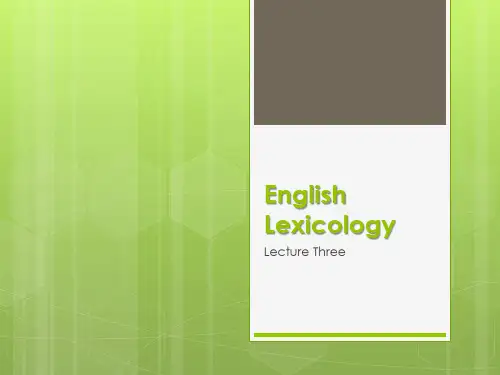
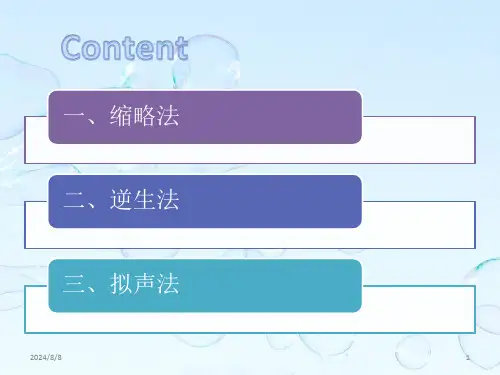
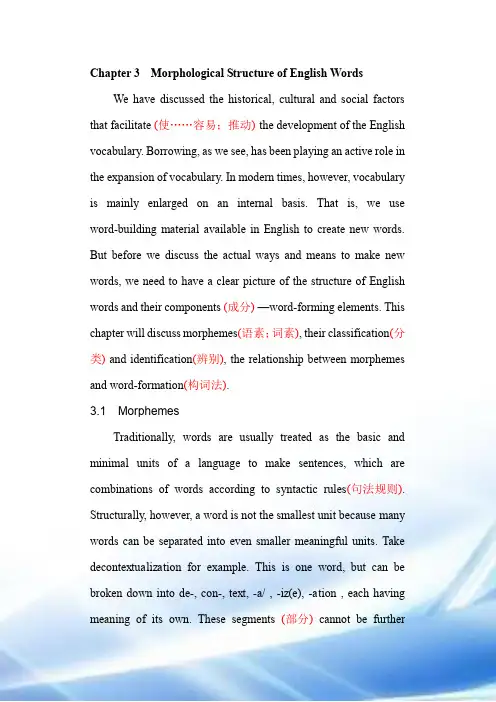
Chapter 3 Morphological Structure of English Words We have discussed the historical, cultural and social factors that facilitate (使……容易;推动) the development of the English vocabulary. Borrowing, as we see, has been playing an active role in the expansion of vocabulary. In modern times, however, vocabulary is mainly enlarged on an internal basis. That is, we use word-building material available in English to create new words. But before we discuss the actual ways and means to make new words, we need to have a clear picture of the structure of English words and their components (成分) —word-forming elements. This chapter will discuss morphemes(语素;词素), their classification(分类) and identification(辨别), the relationship between morphemes and word-formation(构词法).3.1 MorphemesTraditionally, words are usually treated as the basic and minimal units of a language to make sentences, which are combinations of words according to syntactic rules(句法规则). Structurally, however, a word is not the smallest unit because many words can be separated into even smaller meaningful units. Take decontextualization for example. This is one word, but can be broken down into de-, con-, text, -a/ , -iz(e), -ation , each having meaning of its own. These segments (部分) cannot be furtherdivided; otherwise, none of them would make any sense. Though -ation has a number of variants (变体) such as -tion, -sion, -ion, they belong to the same suffix as they have the same meaning and grammatical function and occur owing to (因为;根据) different sound environment. These minimal meaningful units are known as morphemes (morphe is the Greek word for 'form'; -eme as in 'phoneme' (音素) means 'class of' ). In view of word-formation, the morpheme is seen as 'the smallest functioning unit in the composition of words' (Crystal 1985). Syntactically(从句法上看), however, a morpheme is the minimal form of grammatical analysis (语法分析). For instance, each of the word-forms studies, studying, studied, consists of the morpheme study + ; the forms -es in studies, -ing in studying, -ed in studied are morphemes, which express grammatical concepts (语法概念) instead of deriving new words (See Classifying Morphemes).3.2 Morphs and Allomorphs(词素变体)Morphemes are abstract units, which are realized in speech by discrete units (具体单位) known as morphs(形素). 'They are actual spoken, minimal carriers of meaning' (Bolinger and Sears 1981:43). In other words the phonetic or orthographic strings(语音串或拼写字串)or segments (切分成分;节) which realize morphemes are termed 'morphs' (Bauer 1983:15). The morpheme isto the morph what a phoneme (音位) is to a phone (音素). Most morphemes are realized by single morphs like bird, tree, green , sad, want, desire, etc. . These morphemes coincide (巧合) with words as they can stand by themselves and function freely in a sentence. Words of this kind are called mono-morphemic words. Some morphemes, however, are realized by more than one morph according to their position in a word. For instance, the morpheme of plurality {-s} has a set of morphs in different sound context, e. g. in cats /s/, in bags /z/, in matches /iz/. The alternates (作为替换的事物) /s/, /z/ and /iz/ are three different morphs. The same is true of the link verb morpheme {be}. Its past tense is realized by two distinct orthographic forms was , were, each of which happens to be a word-form, realizing {preterit} and {singular}, and {preterit} and {plural} respectively and each has its own phonetic form /woz/ or /wə:/. Therefore, both was, were and their phonetic forms /woz/ and /wə: / are morphs (See discussion i n Bauer, p15).An allomorph refers to a member of a set of morphs, which represent one morpheme. Just as we class phones(音素) together as allophones (音位变体) of a single phoneme(音位), so we class morphs together as allomorphs of a single morpheme. Take the plural morpheme {-s} again. Phonetically, it is realized by /s/, /z/, /iz/, all of which are allomorphs. In English, many morphemes canhave more than one allomorph, particularly those freestanding morphemes which are functional words in their own right. Once they occur in connected speech, they may be realized by different forms, depending on whether they are accented or weakened (Look at the data in the table).Morphem e AllomorphStrong Weak{am} /aem/ /əm/, /m/{ was} /woz/ /WəZ/{have } /haev/ /həv/, /v/{would } /wud/ /wəd/, /əd/,/d/{he} /hi:/ /i:/, /i/{his} /hiz/ /iz/{for} /fo:/ /fə/{to} /tu:/ /tu/, /tə/Then what is the difference between morphs and allomorphs? The relationship can be illustrated by the diagram below.Morpheme{would}morph morph morph morph →allomorph/wud/ /wəd/ /əd/ /d/3.3 Classifying MorphemesMorphemes vary in function. Accordingly, we can classify morphemes into several general categories: free versus bound, derivational versus inflectional, and lexical versus grammatical. However, their boundaries are not as clear-cut as they appear to be due to some overlapping(重叠). For the sake of discussion, we shall define each type in terms of its characteristics.1. Free versus Bound Morphemes(自由词素和粘着词素)This is the easiest and most preferred classification in morphological studies, discussed in Hatch and Brown (1995), Crystal (1985), Fromkin and Rodman (1983), Bauer (1983), Bolinger and Sears (1981) and Matthews (2000). Morphemes which are independent of other morphemes are free. These morphemes have complete meanings in themselves and can be used as free grammatical units in sentences. They are identical with(和……完全相同) words, for example, man, earth, wind, car and anger.Morphemes which cannot occur as separate words are bound. They are so named because they are bound to other morphemes to form words or to perform a particulargrammatical function.Bound morphemes are chiefly found in derived words (派生词). Let us take recollection, idealistic and ex-prisoner for example. Each of the three words comprises three morphemes: recollection (re- collect-ion) , idealistic (ideal-ist-ic) , ex-prisoner (ex- prison -er). Of the nine morphemes, collect, ideal and prison can stand by themselves and thus are free morphemes. All the rest re-, -ion , -ist, -ic, ex-and -er are bound as none of them are freestanding units.Free morphemes are all roots, which are capable of being used as words or as word-building elements to form new words like collect, ideal, prison , whereas bound morphemes consist of either roots or affixes, most of which can be used to create new words like -dict- , -ced- (接近;去), re-, -ion, -ist, -ic and ex-(前). But there are a few affixes which can only indicate such grammatical concepts as tense, aspect, number and case, for example, the -ing in watching, -er in easier, -s in books, and -ed in worked.The English language possesses a multitude of (大量的) words made up of merely bound morphemes, e. g. antecedent, which can be broken down into ante-, -ced- and -ent. Among them, -ced- is a root meaning 'approach, go to', ante-, a prefix meaning 'before' and -ent, a noun suffix meaning 'a person, a thing', thus the whole word antecedent meaning 'something that goes before'(前例;前事;先行词;祖先). These examples show clearly that bound morphemes include two types: bound root (See Root, Stem, Base) and affix.2. Derivational versus Inflectional MorphemesMorphemes which are used to derive new words are known as derivational morphemes (派生词素) because when these morphemes are conjoined, new words are derived.In English, derivatives and compounds are all formed by such morphemes. For example, a + mor + ai, clear + ance, Life + Like and homo + gen + eous are results of such morphological processes.Inflectional morphemes(屈折词素), in contrast, indicate the syntactic relationships between words and function as grammatical markers. Inflectional morphemes are confined to suffixes. There is the regular plural suffix -s (-es) which is added to nouns such as machines, fridges, desks, radios and potatoes; the same forms can be added to verbs to indicate the simple present for the third person singular such as likes, works and goes; the form -'s is used to denote the possessive case of nouns such as the children ' s library, the man ' s role and the mother-in-law' s complaints; the suffixes -er, -est are usually attached to simple adjectives or adverbs to show their comparative or superlative degrees like happier—happiest,harder—hardest. Apart from these, there is the past tense marker -ed and progressive marker -ing added to verbs. The differences between inflectional and derivational morphemes can be summarized as follows (See Hatch and Brown, p266): Inflectional Derivational(1) Does not change meaning or part of speech of the stem (1) Changes meaning or part of speech of the stem.(2) Indicates syntactic or semantic relations between different words in a sentence.(2) Indicates semantic relations within the word.(3) Occurs with all members of some large class of morphemes.(3) Occurs with only some members of a class of morphemes.(4) Occurs at margins of words.(4) Occurs before any inflectional suffixes added.3. Content versus Grammatical MorphemesOn a semantic and syntactic basis, morphemes can fall into content and grammatical morphemes (Traugott and Pratt 1980:90; Bolinger and Sears, pp66~70; Hatch and Brown, p267). Content morphemes are lexical morphemes which are used as wesee above to derive new words, so also known as derivational morphemes. These morphemes, whether free or bound, have a lexical content, hence the name. Grammatical morphemes, on the other hand, function primarily as grammatical markers. They encompass both inflectional affixes and free morphemes such as in, and, do, have, they, -while, -where, but and that, which are traditionally called functional words.3.4 Identifying Morphemes(词素的区分)Since morphemes are the minimal distinct units, they should be identifiable by their forms, meaning and distribution. Generally speaking, lexical morphemes are easy to define:Mono-morphemic: land, skyDouble-morphemic: chill + y, mis + takeTriple-morphemic: anti + govern + ment, sports + man + shipFour-morphemic:un + friend + li + ness, morph + olog( i) + cal + lyOver-four-morphemic: inter + nation + al + iz(e) + ationIf the morphemes are always consistent in form and meaning, there should be no difficulty in identification(区分). However, thereis often mismatch(不一致)between form and meaning. Some morphemes are identical(相同的) in form but different in meaning, for instance, -er in teacher, clearer and eraser. -er in teacher means 'one who', but -er in clearer indicates 'the comparative degree', and -er in eraser denotes 'an object'. Therefore, -er in each case is a different morpheme.Some morphemes are not meaningful in isolation(单独)but acquire meaning by virtue of(通过)their connection in words (Fromkin and Rodman, p116). The classic examples are cranberry(越橘), huckleberry (黑果;乌饭树浆果)and boysenberry(博弈增莓), each seeming to be a kind of berry. But when cran-, huckle- and boysen- are isolated, they are meaningless and they are incapable of forming new words with other morphemes rather than with berry. There are other morphemes which occur in many words, but their meaning is difficult to define, for instance, -ceive in conceive (想象;设想), perceive(感觉,察觉;认为)and receive. Some forms are meaningful, but not morphemes, such as fl- meaning 'moving light' in flash , flame and flicker(闪烁,忽隐忽现), and gl-meaning 'static light' in glow(发光,燃烧),glisten (闪耀;反光)and glitter(闪光;光彩夺目). These are only sound symbols often employed by poets in their literary creation but do not qualify as morphemes.The identification of inflectional morphemes is more problematic. In most cases, an inflectional morpheme can be segmented (切分)from the stem of a word and naturally can be added to the stem like the plural morpheme {s} in gloves, tables and classes. But what is the plural morpheme in men, sheep and feet ? The same is true of the past tense morpheme {ed} , which is explicit and segmentable in walked, loaded and danced. How can we isolate the past tense morpheme from knew, taught and cut ? To solve the problem, we have to resort to other ways.3.5 Morpheme and Word-formationWe know that words can be analyzed into morphemes, which are the minimal meaningful units in the composition of words. In word-formation, however, morphemes are conventionally labeled root, stem, base and affix.1. AffixAffixes are forms that are attached to words or word elements to modify meaning or function. All affixes are bound morphemes because none of them can stand as words in their own right. According to the functions of affixes, we can divide them into inflectional affixes like -s, -ed and -ing, and derivational affixeslike pre-, ex-, de-, -less, -dom and -ic. Derivational and inflectional affixes are identical with derivational and inflectional morphemes. In view of their distribution in the formation of words, affixes can fall into prefix and suffix. Prefixes are all derivational, i.e. they are used to form new words whereas suffixes embrace(包括) both derivational suffixes and inflectional suffixes. Accordingly, the above-mentioned affixes can be further grouped into prefixes: pre-, ex- and de-y and suffixes: -less, -dom, -zc, -5, -ed and -ing.2. Root, Stem, BaseBefore we begin our actual discussion of word-building processes, there are some basic concepts that need clarifying(澄清). The processes of derivation and compounding involve different word-forming elements: affixes and root or stem or base. Indeed, some people use root or stem undiscriminatingly (不加区别地) on all occasions. But these three terms are not the same, and they denote to a greater or lesser degree different concepts despite the semantic overlapping between them.A root is the basic form of a word which cannot be further analyzed without total loss of identity (Crystal 1985). As mentioned earlier, the root, whether free or bound, generally carries the maincomponent of meaning in a word. In the word internationalists, removing inter- , -at, -ist, -s leaves the root nation. If we further divide nation as * na/tion or * at /ion, though -tion and -ion coincide with the noun suffix, the other part is meaningless and the original lexical identity is totally lost. Therefore, nation defies(使不能;使落空)further analysis. In terms of derivational and inflectional morphology, a 'root is that part of a word form that remains when all inflectional and derivational affixes have been removed' (Bauer 1983). Take internationalists again. After the removal of the inflectional affix -s and the derivational affixes -ist, -al and inter-, nation is what is left and thus is the root.A stem may consist of a single root morpheme as in iron or of two root morphemes as in a compound like handcuff. It can be a root morpheme plus one or more affixational morphemes as in mouthful, understatement. To make things more clearly, we say that the stem is used only when we deal with inflectional affixes. As Bauer defines, a stem is 'that part of the word-form which remains when all inflectional affixes have been removed' (ibid). In other words, any form to which an inflectional affix is attached is a stem. Consider the word internationalists again. Nation is a root as well as a stem as the plural -s can be added to it; national is not a root as it can be further divided, but a stem because an inflectionalaffix -s can be added to it when used as a noun; similarly, international is not a root but a stem for the same reason. This is also true of internationalist, which is a stem.A base is used in this book as an all-purpose term, referring to a form to which affixes of any kind (both derivational and inflectional) can be added. It can be a root or a stem. In the case of internationalists, nation is a base, national is a base, so are international and internationalist.nation(root, stem, base)national(stem, base)international(stem, base)internationalist (stem, base)InternationalistsIt should be noted that such an example gives the impression that a stem is just as good as a base. This is not true. In many cases, a form of word can neither be a root nor a stem, but only a base. This often happens when we deal with derivational affixes exclusively, for example impracticality(不切实际;无用;不现实). Removing the derivational affix -ity leaves only the base form impractical, and by further removing im- we have the base form practical left and by still further analysis, only practice remains.impracticalityimpractical (base)practical(base)practice(root, stem, base)Therefore, in the chapters to follow, we shall employ only the term base to refer to any basic word-building element.英语词汇学第三单元课后练习及答案Questions and Tasks1. Write the terms in the blanks according to the definitions.a. a minimal meaningful unit of a language ( )b. one of the variants that realize a morpheme ( )c. a morpheme that occurs with at least one other morpheme ( )d. a morpheme that can stand alone ( )e. a morpheme attached to a base, stem or root ( )f. an affix that indicates grammatical relationships ( )g. an affix that forms new words with a base, stem or root ( )h.what remains of a word after the removal of all affixes ( )i. that part of a word that can take inflectional affixes ( ) j. a form to which affixes of any kind can be added ( )2. What is the difference between grammatical and lexicalmorphemes, and inflectional and derivational morphemes?Give examples to illustrate their relationships.3. Analyze the words in terms of root, stem and base.individualistic undesirablesanize the following terms in a tree diagram to show their logical relationships.affix morphemederivational affix free rootbound root inflectional affixprefix free morphemebound morpheme suffix参考答案1. a. morphemeb. allomorphc. bound morphemed. free morphemee. affixf. inflectional affixg. derivational affixh. rooti. stemj. base2. Inflectional morphemes are the suffixes added to the end ofwords to denote grammatical concepts such as -s (-es) , -ed,-ing and -est (to show superlative degree of adjectives andadverbs) whereas derivational morphemes are prefixes andsuffixes added to words to form new words such as pre-, dis-, un- , -lion, -er, -ness and so on.Grammatical morphemes are those used to show grammatical concepts, including inflectional suffixes as mentioned above and functional words (prepositions, pronouns, articles,auxiliary verbs), for example, but, the, do and was; lexicalmorphemes are derivational affixes including both prefixesand suffixes.3.individualisticindividualist+ic[stem, base]individual+ist[stem, base]individu+al[stem, base]in+dividu[root, stem, base]undesirablesun+desirable[stem, base]desir+able[root, stem, base]4. morpheme free morpheme=free rootbound morpheme bound rootaffix inflectional affixderivational affix prefixsuffix。
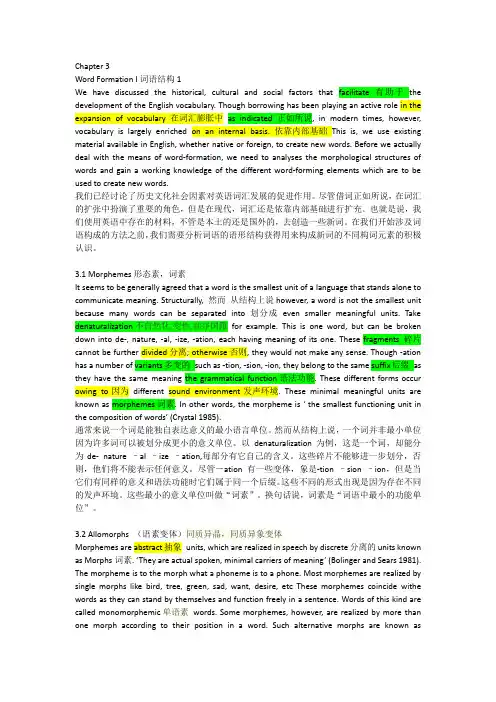
Chapter 3Word Formation I词语结构1We have discussed the historical, cultural and social factors that facilitate 有助于the development of the English vocabulary. Though borrowing has been playing an active role in the expansion of vocabulary在词汇膨胀中as indicated正如所说, in modern times, however, vocabulary is largely enriched on an internal basis. 依靠内部基础This is, we use existing material available in English, whether native or foreign, to create new words. Before we actually deal with the means of word-formation, we need to analyses the morphological structures of words and gain a working knowledge of the different word-forming elements which are to be used to create new words.我们已经讨论了历史文化社会因素对英语词汇发展的促进作用。
尽管借词正如所说,在词汇的扩张中扮演了重要的角色,但是在现代,词汇还是依靠内部基础进行扩充。
也就是说,我们使用英语中存在的材料,不管是本土的还是国外的,去创造一些新词。
在我们开始涉及词语构成的方法之前,我们需要分析词语的语形结构获得用来构成新词的不同构词元素的积极认识。
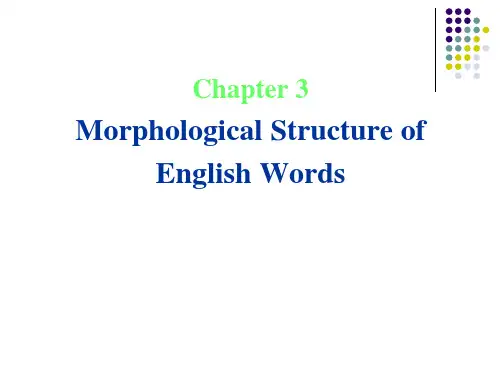
英语专业词汇学第三章课本及答案Chapter 3 Morphological Structure of English Words We have discussed the historical, cultural and social factors that facilitate (使……容易;推动) the development of the English vocabulary. Borrowing, as we see, has been playing an active role in the expansion of vocabulary. In modern times, however, vocabulary is mainly enlarged on an internal basis. That is, we use word-building material available in English to create new words. But before we discuss the actual ways and means to make new words, we need to have a clear picture of the structure of English words and their components (成分) —word-forming elements. This chapter will discuss morphemes(语素;词素), their classification(分类) and identification(辨别), the relationship between morphemes and word-formation(构词法).3.1 MorphemesTraditionally, words are usually treated as the basic and minimal units of a language to make sentences, which are combinations of words according to syntactic rules(句法规则). Structurally, however, a word is not the smallest unit because many words can be separated into even smaller meaningful units. Take decontextualization for example. This is one word, but can be broken down into de-, con-, text, -a/ , -iz(e), -ation , each having meaning of its own. These segments (部分) cannot be furtherdivided; otherwise, none of them would make any sense. Though -ation has a number of variants (变体) such as -tion, -sion, -ion, they belong to the same suffix as they have the same meaning and grammatical function and occur owing to (因为;根据) different sound environment. These minimal meaningful unitsare known as morphemes (morphe is the Greek word for 'form'; -eme as in 'phoneme' (音素) means 'class of' ). In view of word-formation, the morpheme is seen as 'the smallest functioning unit in the composition of words' (Crystal 1985). Syntactically(从句法上看), however, a morpheme is the minimal form of grammatical analysis (语法分析). For instance, each of the word-forms studies, studying, studied, consists of the morpheme study + ; the forms -es in studies, -ing in studying, -ed in studied are morphemes, which express grammatical concepts (语法概念) instead of deriving new words (See Classifying Morphemes).3.2 Morphs and Allomorphs(词素变体)Morphemes are abstract units, which are realized in speech by discrete units (具体单位) known as morphs(形素). 'They are actual spoken, minimal carriers of meaning' (Bolinger and Sears 1981:43). In other words the phonetic or orthographic strings(语音串或拼写字串)or segments (切分成分;节) which realize morphemes are termed 'morphs' (Bauer 1983:15). The morpheme isto the morph what a phoneme (音位) is to a phone (音素). Most morphemes are realized by single morphs like bird, tree, green , sad, want, desire, etc. . These morphemes coincide (巧合) with words as they can stand by themselves and function freely in a sentence. Words of this kind are called mono-morphemic words. Some morphemes, however, are realized by more than one morph according to their position in a word. For instance, the morpheme of plurality {-s} has a set of morphs in different sound context, e. g. in cats /s/, in bags /z/, in matches /iz/. The alternates (作为替换的事物) /s/, /z/ and /iz/ are three different morphs. The same is true of the link verb morpheme {be}. Its past tense is realized by two distinct orthographic forms was , were,each of which happens to be a word-form, realizing {preterit} and {singular}, and {preterit} and {plural} respectively and each has its own phonetic form /woz/ or /w?:/. Therefore, both was, were and their phonetic forms /woz/ and /w?: / are morphs (See discussion i n Bauer, p15).An allomorph refers to a member of a set of morphs, which represent one morpheme. Just as we class phones(音素) together as allophones (音位变体) of a single phoneme(音位), so we class morphs together as allomorphs of a single morpheme. Take the plural morpheme {-s} again. Phonetically, it is realized by /s/, /z/, /iz/, all of which are allomorphs. In English, many morphemes can have more than one allomorph, particularly those freestanding morphemes which are functional words in their own right. Once they occur in connected speech, they may be realized by different forms, depending on whether they are accented or weakened (Look at the data in the table).Morphem e AllomorphStrong Weak{am} /aem/ /?m/, /m/{ was} /woz/ /W?Z/{have } /haev/ /h?v/, /v/{would } /wud/ /w?d/, /?d/,/d/{he} /hi:/ /i:/, /i/{his} /hiz/ /iz/{for} /fo:/ /f?/{to} /tu:/ /tu/, /t?/Then what is the difference between morphs and allomorphs? The relationship can be illustrated by the diagram below.Morpheme{would}morph morph morph morph →allomorph/wud/ /w?d/ /?d/ /d/3.3 Classifying MorphemesMorphemes vary in function. Accordingly, we can classify morphemes into several general categories: free versus bound, derivational versus inflectional, and lexical versus grammatical. However, their boundaries are not as clear-cut as they appear to be due to some overlapping(重叠). For the sake of discussion, we shall define each type in terms of its characteristics.1. Free versus Bound Morphemes(自由词素和粘着词素)This is the easiest and most preferred classification in morphological studies, discussed in Hatch and Brown (1995), Crystal (1985), Fromkin and Rodman (1983), Bauer (1983), Bolinger and Sears (1981) and Matthews (2000). Morphemes which are independent of other morphemes are free. These morphemes have complete meanings in themselves and can be used as free grammatical units in sentences. They are identical with(和……完全相同) words, for example, man, earth, wind, car and anger.Morphemes which cannot occur as separate words are bound. They are so named because they are bound to other morphemes to form words or to perform a particular grammatical function.Bound morphemes are chiefly found in derived words (派生词). Let us take recollection, idealistic and ex-prisoner for example. Each of the three words comprises three morphemes: recollection (re- collect-ion) , idealistic (ideal-ist-ic) , ex-prisoner (ex- prison -er). Of the nine morphemes, collect, ideal and prison can stand by themselves and thus are free morphemes. All the rest re-, -ion , -ist, -ic, ex-and -er are boundas none of them are freestanding units.Free morphemes are all roots, which are capable of being used as words or as word-building elements to form new words like collect, ideal, prison , whereas bound morphemes consist of either roots or affixes, most of which can be used to create new words like -dict- , -ced- (接近;去), re-, -ion, -ist, -ic and ex-(前). But there are a few affixes which can only indicate such grammatical concepts as tense, aspect, number and case, for example, the -ing in watching, -er in easier, -s in books, and -ed in worked.The English language possesses a multitude of (大量的) words made up of merely bound morphemes, e. g. antecedent, which can be broken down into ante-, -ced- and -ent. Among them, -ced- is a root meaning 'approach, go to', ante-, a prefix meaning 'before' and -ent, a noun suffix meaning 'a person, a thing', thus the whole word antecedent meaning 'something that goes before'(前例;前事;先行词;祖先). These examples show clearly that bound morphemes include two types: bound root (See Root, Stem, Base) and affix.2. Derivational versus Inflectional MorphemesMorphemes which are used to derive new words are known as derivational morphemes (派生词素) because when these morphemes are conjoined, new words are derived.In English, derivatives and compounds are all formed by such morphemes. For example, a + mor + ai, clear + ance, Life + Like and homo + gen + eous are results of such morphological processes.Inflectional morphemes(屈折词素), in contrast, indicate the syntactic relationships between words and function as grammatical markers. Inflectional morphemes are confined tosuffixes. There is the regular plural suffix -s (-es) which is added to nouns such as machines, fridges, desks, radios and potatoes; the same forms can be added to verbs to indicate the simple present for the third person singular such as likes, works and goes; the form -'s is used to denote the possessive case of nouns such as the children ' s library, the man ' s role and the mother-in-law' s complaints; the suffixes -er, -est are usually attached to simple adjectives or adverbs to show their comparative or superlative degrees like happier—happiest,。
Lecture 3讲授题目:Basic Concepts of Words and Vocabulary所属章节:《现代英语词汇学概论》第1章计划学时:2 periods教学方法:传统讲授法参考资料:《英语词汇学教程》、《英语词汇学》教学目的和要求:通过本单元的学习,学生对词的定义,词汇的分类等词的基本知识有了一定的了解。
教学重点:1) What is a word?2) The relationship between soundand meaning.3) Classification of English words.教学难点:1) The definition of word.2) Classification of words.1. What is a wordWhat is a word? This question has occupied the attention of linguists for ages. Although numerous definitions have been suggested, none of them seem to be perfect. Scholars don‘t agree on the definition of the word. To sum up, the definition of a word comprises the following points:▪(1) a minimal free form of a language;(一门语言中最小的自由形式)▪ (2) a sound unity;(一个声音统一体)▪ (3) a unit of meaning;(一个意义单位)▪ (4) a form that can function alone in a sentence.(在句子中能独立起作用的一个形式)Therefore, we can say that a word is ―a minimal free form of a language that has a given sound and meaning and syntacticfunction‖.(词是一门语言中具有一定的声音、意义和句法功能的最小的自由形式。
Lecture 3讲授题目:Basic Concepts of Words and Vocabulary所属章节:《现代英语词汇学概论》第1章计划学时:2 periods教学方法:传统讲授法参考资料:《英语词汇学教程》、《英语词汇学》教学目的和要求:通过本单元的学习,学生对词的定义,词汇的分类等词的基本知识有了一定的了解。
教学重点:1) What is a word?2) The relationship between soundand meaning.3) Classification of English words.教学难点:1) The definition of word.2) Classification of words.1. What is a wordWhat is a word? This question has occupied the attention of linguists for ages. Although numerous definitions have been suggested, none of them seem to be perfect. Scholars don‘t agree on the definition of the word. To sum up, the definition of a word comprises the following points:▪(1) a minimal free form of a language;(一门语言中最小的自由形式)▪ (2) a sound unity;(一个声音统一体)▪ (3) a unit of meaning;(一个意义单位)▪ (4) a form that can function alone in a sentence.(在句子中能独立起作用的一个形式)Therefore, we can say that a word is ―a minimal free form of a language that has a given sound and meaning and syntacticfunction‖.(词是一门语言中具有一定的声音、意义和句法功能的最小的自由形式。